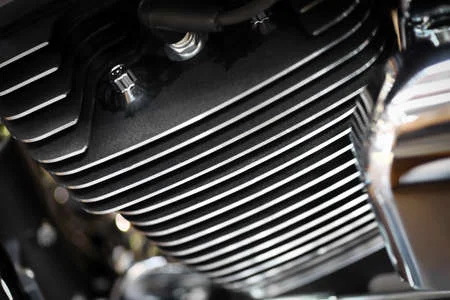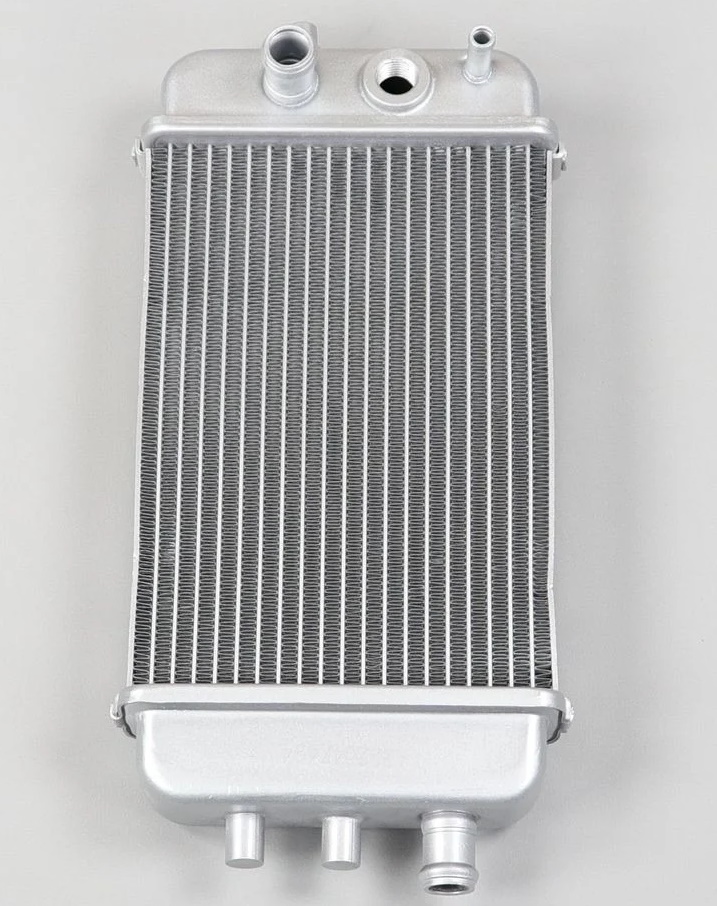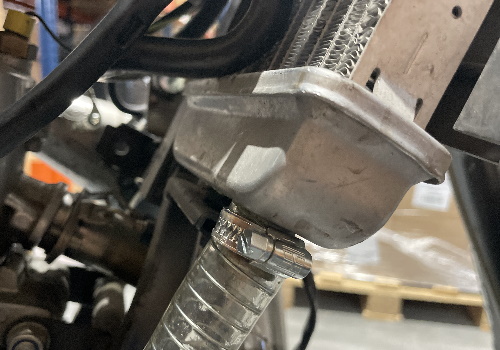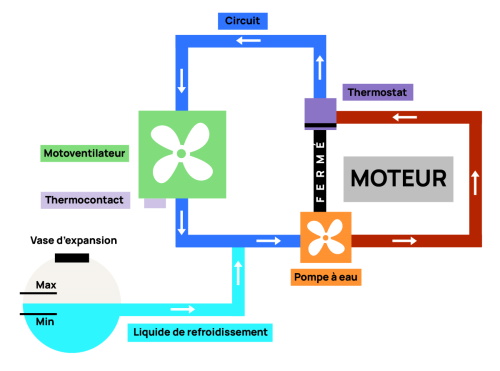Understanding motorcycle engine cooling
In theory, the power drained into the circuit from refroidissement is equivalent to half the power developed at the crankshaft. The amount of energy released being proportional to the power supplied, the problem is not the same at idle or during heavy acceleration.
![]()

The cooling par air
The first engines were cooled par air. No pump, no radiator, no circuit. Just a few fins increased the exchange surface to evacuate the calories. But the concept has its limits: in winter, the engine does not heat up enough, in summer the engine heats up too much.
The cylinder and the cylinder head are surrounded by numerous fins which dissipate the heat into the ambient air, these fins increase the cooling surface.
Cooling can be further increased par the addition of aluminum alloys. The 2 and 4 engines have a fundamental difference, at the level of the organs to be cooled.
On a 2 engine, the exhaust is par the cylinder, and on an engine at 4 it is done par the cylinder head, hence a difference in temperature on these elements.
Air cooling limits engine configurations and makes certification difficult due to the noise and vibrations generated.ar the fins.
The next step was cooling par forced air, usually used for scooters. The motor is enclosed in a kind of shell, a fan driven par the crankshaft blows inside this "shell". The faster the engine runs, the harder the fan blows.
The quality of the carburation evolves with the temperature of the engine.
![]()
The cooling par liquid
A heat transfer fluid evacuates the heat emitted par the engine to a location and device conducive to cooling. It is almost always a radiator placed at the front of the motorcycle. The advantage is that you can limit the circulation of water when the engine is cold, to enable it to quickly reach its correct operating temperature and thus reduce the wear and pollution.
This role is assigned to the thermostat, a sort of metallic membrane placed in the water circuit which opens or closes depending on the temperature of the liquid. Conversely, if the engine is too hot, the thermostat, a sort of calibrated electrical switch activated under the effect of the temperature, can trigger the fan. We can therefore easily regulate the temperature of the engine! As a bonus, the absence of fins reduces mechanical noise and the small water mattress that surrounds the cylinders somewhat isolates the slamming of the pistons, which suits the manufacturers for homologation.


There are therefore only advantages, apart from the cost, the weight, the complexity and the risk of breakdowns. Leaking cylinder head gaskets, stones puncturing the radiator, scaling or overpressure in the circuit, puncturing pipes, clamps loosening, freezing, etc.
The cooling circuit of an engine is divided into a small and a large circuit. The small cooling circuit excludes the thermostatically controlled radiator (large cooling circuit) to warm the system up to operating temperature faster.
![]()

The cooling circuit
The latter is based on the circulation of a liquid at low temperature directing the calories to the radiator in order to release them into the air.
System whose objective is to cool the engine and avoid the risk of overheating, it is based on the circulation of a liquid at low temperature which recovers the calories of the engine , conveys them to the radiator where they are evacuated.
The hoses : pipes allowing the circulation of the liquid.
Le radiator : allows the liquid to cool.
La water pump : liquid flow accelerator, used to circulate the liquid in the circuit.
The thermostat or thermostat : manages the opening and closing of the cooling circuit. Valve that controls the flow of coolant.
Le expansion tank and the valve cap: reservoir containing the coolant. Stabilizes the pressure in the cooling circuit. Its cap acts to purge the air contained in the coolant. The expansion tank overcomes the change in pressure in the cooling circuit.
Le coolant : composed of water, glycol and additives that prevent freezing and boiling. Pours into the expansion tank. Heat transfer fluid.
The fan(s) : also called radiator fan, blows air when the temperature is too high.
La temperature sensor : measures the coolant temperature at the cylinder head. She warns the pilot par the ignition of the engine warning light on the dashboard.
Le dashboard light : allows you to control the temperature of your engine, thanks to the temperature needle which indicates the temperature level. When this rises to its maximum, this is a sign of overheating, it is then more prudent to stop.
![]()
How it works
When starting, the engine must warm up quickly to operate efficiently and avoid excessive fuel consumption. However, past the 120°C mark, some engine parts begin to degrade. To keep them at the right temperature (between 75 and 95°C) the engine therefore needs to be cooled, this is the role of the cooling circuit.
In order to favor the rise in temperature of the engine, the circuit is reduced par the thermostat. When the engine is hot, the thermostat opens, which allows the liquid to arrive in the other part of the circuit in order to avoid overheating. The hot liquid, at the exit of the engine block, is sent to the radiator which cools it thanks to the flow of air. The cooled liquid passes par the engine block to cool it down and maintain a temperature of around 90°C.
Cooling circuit functions
Refroidissement: maintains the walls proximitated the combustion chamber at the right temperature. The liquid absorbs the calories and evacuates them par through the radiator.
Temperature controller: as the engine warms up, the valve opens to allow fluid to flow to the radiator, regulating the temperature and keeping it at an average of 90°F.
Pressure regulator: pressure is increased to retard the boiling point of a liquid. The plug establishes a pressure of 1 bar and equalizes it to atmospheric pressure when the engine cools.












